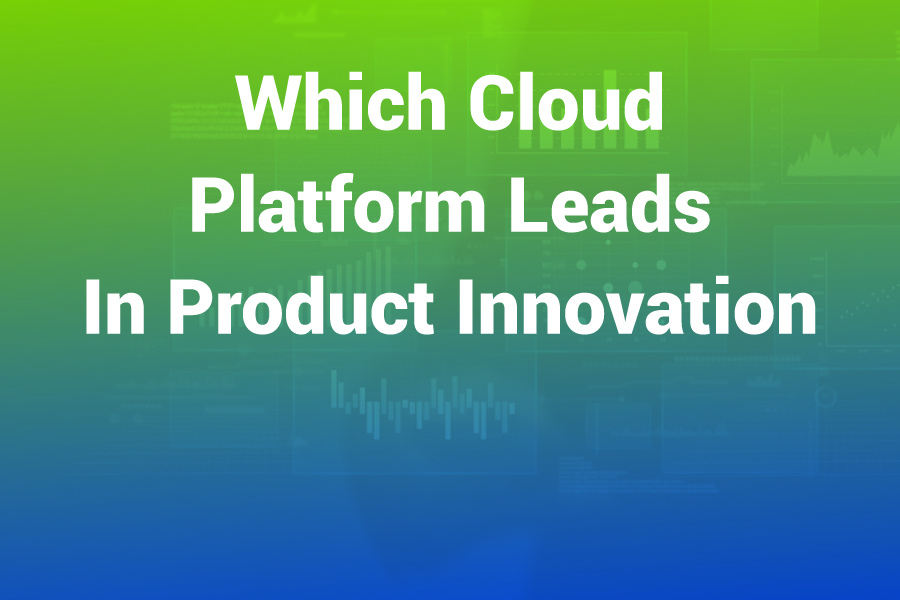
In today’s hyper-competitive business landscape, product innovation isn’t just a luxury—it’s a survival imperative. Companies are increasingly turning to cloud platforms to accelerate their innovation cycles, but the big question remains: which cloud platform leads in product innovation? As organizations race to develop cutting-edge products and services, the choice of cloud infrastructure can make or break their innovation potential. Let’s dive into how the major cloud providers stack up when it comes to fueling product innovation.
Defining Innovation in the Cloud Era
Before we can determine which cloud platform leads in product innovation, we need to understand what innovation means in today’s digital context. Product innovation has evolved beyond simply creating new features—it now encompasses rapid prototyping, AI-driven development, IoT integration, and continuous delivery models that transform ideas into market-ready solutions faster than ever.
Cloud platforms have become the backbone of modern innovation, providing the tools, infrastructure, and services that enable companies to experiment, iterate, and scale with unprecedented speed. The right cloud environment can compress development cycles from months to weeks, allowing businesses to respond to market changes with agility and confidence.
Key Innovation Metrics
When evaluating cloud platforms for innovation capabilities, several key metrics come into play. Time-to-market for new products, the ability to experiment at scale, access to cutting-edge technologies like AI and machine learning, and the robustness of development tools all contribute to a platform’s innovation potential. Companies that leverage these capabilities effectively can outperform competitors by significant margins.
According to [SOURCE: Gartner Research], organizations that prioritize cloud-enabled innovation report 2.6 times higher revenue growth compared to industry peers. This statistic underscores the critical importance of selecting the right cloud platform for innovation initiatives. Understanding which cloud platform leads in product innovation requires examining how each provider addresses these crucial innovation metrics.
AWS: The Innovation Pioneer
Amazon Web Services (AWS) has long been considered the frontrunner in cloud innovation, and for good reason. As the first major cloud provider, AWS has maintained its leadership position through continuous expansion of its service portfolio and relentless focus on customer-driven innovation. With over 200 fully featured services, AWS offers the most comprehensive toolkit for product development teams.
AWS’s innovation ecosystem is built around three core strengths: unmatched service breadth, a massive partner network, and a culture of experimentation. Services like AWS Lambda for serverless computing, SageMaker for machine learning, and IoT Core for connected devices provide developers with powerful building blocks for innovative products. The AWS Activate program specifically supports startups with credits, technical support, and resources designed to accelerate innovation.
AWS Innovation Tools and Services
AWS excels in providing specialized tools that address specific innovation challenges. AWS DeepLens combines machine learning with video cameras for computer vision projects, while AWS RoboMaker helps developers build, simulate, and deploy robotics applications. These specialized services demonstrate AWS’s commitment to enabling innovation across diverse industries and use cases.
The AWS Innovation Sandbox allows teams to experiment with new ideas in a controlled environment, reducing the risk and cost associated with innovation. This approach aligns with AWS’s broader philosophy of enabling “fail fast, learn faster” development cycles. For organizations asking which cloud platform leads in product innovation, AWS’s comprehensive toolset makes a compelling case, particularly for teams that value flexibility and extensive service options.
Microsoft Azure: The Enterprise Innovator
Microsoft Azure has emerged as a formidable contender in the cloud innovation space, particularly for enterprise organizations. Azure’s strength lies in its seamless integration with Microsoft’s extensive product ecosystem, including Office 365, Dynamics 365, and GitHub. This integration creates a unified environment for innovation that leverages familiar tools and workflows.
Azure’s innovation capabilities are particularly strong in areas like hybrid cloud scenarios, AI and machine learning, and developer productivity. Azure DevOps provides a comprehensive set of tools for planning, developing, testing, and deploying applications, while Azure Machine Learning offers both code-first and drag-and-drop approaches to AI development. These capabilities make Azure especially attractive for organizations already invested in Microsoft technologies.
Azure’s Unique Innovation Propositions
Azure differentiates itself through several unique innovation-focused services. Azure Sphere provides a secured solution for creating connected devices on the Internet of Things, while Azure Digital Twins enables organizations to create comprehensive digital models of physical environments. These specialized services address specific innovation challenges that many enterprises face.
The Microsoft for Startups program offers eligible companies up to $150,000 in Azure credits, along with technical support and access to Microsoft’s sales channels. This initiative demonstrates Azure’s commitment to fostering innovation across the business spectrum. When evaluating which cloud platform leads in product innovation, Azure’s enterprise integration and specialized industry solutions make it a top choice for organizations with complex innovation requirements.
Google Cloud Platform: The AI-First Innovator
Google Cloud Platform (GCP) has positioned itself as the leader in AI and data-driven innovation, leveraging Google’s decades of experience in search, machine learning, and large-scale data processing. GCP’s innovation ecosystem is built around three core pillars: data analytics, artificial intelligence, and open-source technologies.
GCP’s AI and machine learning capabilities are particularly noteworthy. TensorFlow, Google’s open-source machine learning framework, has become the industry standard for AI development. Cloud AutoML enables developers with limited machine learning expertise to train high-quality models, while AI Platform provides a comprehensive environment for building, deploying, and managing AI models at scale.
GCP’s Innovation Accelerators
Google Cloud offers several specialized services designed to accelerate innovation in specific domains. Cloud IoT Edge enables AI and machine learning at the edge, bringing intelligence closer to where data is generated. Apigee API Management helps organizations design, secure, and scale APIs, which are crucial building blocks for innovative digital products.
The Google for Startups Cloud Program provides eligible startups with technical support, training, and up to $100,000 in cloud credits. This program is particularly valuable for companies working on cutting-edge technologies that can benefit from Google’s technical expertise. For organizations focused on AI and data-driven innovation, GCP presents a compelling answer to the question of which cloud platform leads in product innovation.
Comparative Analysis: Innovation Capabilities
When directly comparing the innovation capabilities of AWS, Azure, and GCP, several key differences emerge. AWS leads in service breadth and ecosystem maturity, offering the most comprehensive set of tools for diverse innovation scenarios. Azure excels in enterprise integration and hybrid cloud innovation, making it ideal for organizations with complex IT environments. GCP stands out in AI and data analytics, providing the most advanced tools for data-driven innovation.
The choice between platforms often depends on an organization’s specific innovation priorities. Companies focused on rapid experimentation and broad service options tend to favor AWS. Enterprises with existing Microsoft investments typically find Azure’s integration capabilities most valuable. Organizations prioritizing AI and data science often choose GCP for its specialized tools and Google’s expertise in these areas.
Performance and Scalability for Innovation
All three platforms offer robust performance and scalability, but with different approaches. AWS provides the most granular control over infrastructure, allowing teams to optimize for specific performance requirements. Azure offers strong performance for Microsoft workloads and hybrid scenarios. GCP leverages Google’s global network and container technologies to deliver consistent performance across regions.
For innovation teams, scalability is particularly crucial as new products may experience rapid growth or variable demand patterns. AWS Auto Scaling, Azure Autoscale, and GCP’s autoscaling capabilities all provide similar functionality, but with different implementation approaches and pricing models. Understanding these differences is essential when evaluating which cloud platform leads in product innovation for specific use cases.
Cost Considerations for Innovation
Innovation initiatives often operate under budget constraints, making cost optimization a critical factor in platform selection. All three cloud providers offer pay-as-you-go pricing models, but with different structures and cost optimization opportunities. AWS provides the most detailed pricing options and the largest ecosystem of third-party cost management tools.
Azure’s cost management benefits from integration with Microsoft Enterprise Agreements, which can provide significant discounts for large organizations. GCP often offers competitive pricing for compute-intensive workloads and sustained use discounts that benefit long-term innovation projects. Each platform also provides free tiers and credits for startups and innovation-focused programs.
Maximizing Innovation ROI
To maximize return on innovation investments, organizations should consider not just direct costs but also the total cost of innovation, including development time, training, and operational overhead. AWS’s extensive documentation and large community can reduce learning curves for new teams. Azure’s integration with familiar Microsoft tools can accelerate productivity for enterprises. GCP’s specialized AI tools can reduce development time for data-intensive projects.
The most effective approach often involves aligning cloud platform selection with the organization’s innovation strategy and existing technical capabilities. [LINK: Cloud Innovation Strategies] provides frameworks for evaluating cloud platforms based on specific innovation goals and requirements. Understanding which cloud platform leads in product innovation requires looking beyond feature lists to consider how well each platform aligns with your organization’s unique innovation processes.
Real-World Innovation Success Stories
Examining real-world examples provides valuable insights into how each platform enables innovation. Netflix, perhaps the most famous AWS customer, has leveraged AWS’s scalability and service breadth to transform from a DVD rental service to a global streaming powerhouse. Netflix’s ability to experiment with new features and rapidly scale successful innovations demonstrates AWS’s innovation-enabling capabilities.
Siemens has utilized Azure’s hybrid cloud capabilities and IoT services to develop innovative digital twin solutions for industrial applications. By creating virtual replicas of physical assets, Siemens enables customers to optimize performance and predict maintenance needs, showcasing Azure’s strength in enterprise innovation scenarios.
GCP Innovation Champions
Spotify leveraged GCP’s data analytics and machine learning capabilities to enhance its music recommendation algorithms and develop new personalized features for users. The ability to process vast amounts of user data and rapidly deploy new AI models has been crucial to Spotify’s product innovation strategy.
These success stories highlight how different organizations have leveraged each platform’s unique strengths to drive innovation. They also demonstrate that which cloud platform leads in product innovation often depends on the specific innovation focus and technical requirements of each organization. [LINK: Cloud Migration Guide] provides additional insights into how companies have successfully transitioned to cloud platforms for innovation.
Future Trends in Cloud Innovation
The cloud innovation landscape continues to evolve rapidly, with all three platforms investing heavily in emerging technologies. Quantum computing represents the next frontier, with all major cloud providers developing quantum computing services. Amazon Braket, Azure Quantum, and Google Quantum Computing are all positioning to lead in this transformative technology.
Edge computing is another critical trend, with AWS Outposts, Azure Stack, and Google Distributed Cloud all extending cloud capabilities to edge locations. This evolution enables new innovation scenarios in manufacturing, retail, healthcare, and other industries where low-latency processing is essential.
AI and Machine Learning Advancements
AI and machine learning continue to be central to cloud platform innovation strategies. AWS is expanding its SageMaker capabilities with new tools for natural language processing and computer vision. Azure is enhancing its Cognitive Services suite with more specialized AI models for industry-specific applications. GCP continues to leverage Google’s AI research, with new services like Vertex AI unifying its machine learning offerings.
These advancements suggest that the answer to which cloud platform leads in product innovation will continue to evolve as technologies mature and new innovation paradigms emerge. Organizations should consider not just current capabilities but also each platform’s vision and investment trajectory when making long-term decisions.
Making the Right Choice for Your Innovation Needs
Selecting the right cloud platform for innovation requires careful consideration of multiple factors. Start by clearly defining your innovation goals and technical requirements. Are you focused on rapid experimentation, AI-driven products, or enterprise-scale innovation? Your priorities will help determine which platform best aligns with your needs.
Consider your team’s existing skills and your organization’s technology ecosystem. Teams with Microsoft expertise may find Azure more accessible, while those with open-source backgrounds might prefer GCP. Organizations with diverse innovation needs might benefit from AWS’s comprehensive service catalog.
Evaluation Framework
Develop a structured evaluation framework to assess each platform against your specific innovation criteria. Consider factors like service availability in your regions, pricing for your expected usage patterns, integration with existing systems, and the availability of required technical skills. [SOURCE: Forrester Research] recommends involving both business and technical stakeholders in the evaluation process to ensure alignment between innovation goals and platform capabilities.
Proof-of-concept projects can provide valuable hands-on experience with each platform before making a commitment. Many organizations find that a multi-cloud approach works best, leveraging different platforms for different innovation initiatives based on their respective strengths.
Conclusion
So, which cloud platform leads in product innovation? The answer depends on your specific innovation needs, technical requirements, and existing ecosystem. AWS leads in service breadth and ecosystem maturity, making it ideal for organizations with diverse innovation requirements. Azure excels in enterprise integration and hybrid scenarios, perfect for organizations with complex IT environments. GCP stands out in AI and data analytics, offering the most advanced tools for data-driven innovation.
The most successful organizations recognize that innovation capability depends not just on the platform itself, but on how effectively they leverage its features within their innovation processes. By aligning cloud platform selection with your innovation strategy and organizational context, you can create a powerful foundation for product innovation that drives competitive advantage and business growth.
FAQ Section
What factors should I consider when choosing a cloud platform for innovation?
When selecting a cloud platform for innovation, consider your specific innovation goals, technical requirements, existing skills and ecosystem, budget constraints, and scalability needs. Evaluate each platform’s strengths in areas like AI/ML, IoT, serverless computing, and development tools. Also consider integration with your current systems, data residency requirements, and the availability of support and expertise. The right choice balances technical capabilities with your organization’s unique innovation context and strategic objectives.
How do cloud platforms specifically enable faster product innovation?
Cloud platforms accelerate product innovation by providing on-demand access to advanced technologies like AI/ML, big data analytics, and IoT services without massive upfront investments. They offer rapid prototyping tools, scalable infrastructure for testing, and automated deployment pipelines that reduce time-to-market. Cloud platforms also enable experimentation through sandbox environments and pay-as-you-go pricing that reduces the financial risk of innovation. Additionally, they provide access to global infrastructure that allows products to scale quickly from prototype to worldwide deployment.
Why is multi-cloud strategy becoming important for product innovation?
Multi-cloud strategies are gaining importance for product innovation because they allow organizations to leverage the unique strengths of different cloud platforms for specific innovation initiatives. This approach avoids vendor lock-in, provides negotiating leverage, and enables organizations to use the best tools for each specific innovation challenge. Multi-cloud also enhances resilience by distributing workloads across platforms and ensures data sovereignty compliance across different regions. As innovation becomes increasingly specialized, the ability to tap into multiple cloud ecosystems becomes a strategic advantage for organizations pursuing diverse innovation initiatives.





